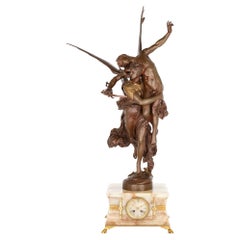Antonin Mercie Mantel Clocks
to
1
1
1
1
1
1
1
1
1
1
1
Height
to
Width
to
1
1
1
2
33
26
25
21
Creator: Antonin Mercie
Antique Patinated Bronze and Onyx Mantel Clock by Mercié and Barbedienne
By Ferdinand Barbedienne, Antonin Mercie
Located in London, GB
Antique patinated bronze and onyx mantel clock by Mercié and Barbedienne
French, Late 19th Century
Height 113cm, width 58cm, depth 40cm
Two renowned French makers, Antonin Mercié (...
Category
Late 19th Century French Neoclassical Antique Antonin Mercie Mantel Clocks
Materials
Onyx, Bronze, Ormolu
Related Items
French Empire Mantel Clock in Ormolu, Patinated Bronze and Marble, Signed Picnot
By Picnot
Located in London, GB
French Empire clock of stunning quality constructed of rouge marble, original fire gilt ormolu and patinated bronze. Set upon four ormolu paw feet to the rouge marble base, rising to...
Category
1810s French Empire Antique Antonin Mercie Mantel Clocks
Materials
Marble, Bronze, Ormolu
$9,839
H 18.5 in W 11.1 in D 5 in
Louis XVI Style Gilt-Bronze Mantel Clock by Henri Picard & Fedinand Barbedienne
By F. Barbedienne Foundry
Located in Los Angeles, CA
A Very Fine French 19th Century Gilt-Bronze Figural Mantel Clock, Horloge à Poser, by Henri Picard and Fedinand Barbedienne - ‘F. Barbédienne & Cie. / A Paris’, after the model by É...
Category
19th Century French Louis XVI Antique Antonin Mercie Mantel Clocks
Materials
Bronze, Ormolu
$46,000 Sale Price
20% Off
H 27.25 in W 22.5 in D 27.25 in
Antique Tiffany & Co. Bronze-Mounted Slate Mantel Clock
By Tiffany & Co.
Located in Tarry Town, NY
An elegant and finely crafted mid-19th century mantel clock by the esteemed Tiffany & Co., New York. This exquisite piece showcases the exceptional quality and attention to detail th...
Category
1850s American Neoclassical Antique Antonin Mercie Mantel Clocks
Materials
Marble, Slate, Brass
Antique Mantel Clock Querubine Gilt Bronze
Located in Ciudad Autónoma Buenos Aires, AR
This functional mantel clock, surrounded by two angels, features a solid gilt bronze frame, hand-crafted and finished. Its mechanism (eight-day movement) is German, and the hand-woun...
Category
1890s German Louis XVI Antique Antonin Mercie Mantel Clocks
Materials
Bronze
Important Late 19th Century Gilt and Patinated Bronze Mantel Clock
Located in Long Island City, NY
A Large and Important Late 19th Century Gilt and Patinated Bronze, French Champlevé Enamel and Wood Mantle Clock
The top figure is of Nike of Samothrace...
Category
19th Century French Belle Époque Antique Antonin Mercie Mantel Clocks
Materials
Bronze, Enamel
Barbedienne French Mantel Clock, circa 1890
By F. Barbedienne Foundry
Located in Brighton, Sussex
A fine quality Louis XVI style French gilded ormolu mantel clock, signed Barbedienne. Having shield and foliate decoration to the top, white enamel roman numerals, a lyre shaped pend...
Category
Late 19th Century French Louis XIV Antique Antonin Mercie Mantel Clocks
Materials
Ormolu
Fine Quality French Gilt and Patinated Bronze Mantel Clock
Located in New York, NY
A fine quality gilt and patinated bronze library clock surmounted on a white oblong base. Having a gilt bronze eagle finial in full relief above a ...
Category
19th Century French Antique Antonin Mercie Mantel Clocks
Materials
Marble, Bronze
Exceptional 19th Century Bronze Entitled ““Quand Meme” by Mercié and Barbedienne
By Antonin Mercie, Ferdinand Barbedienne
Located in Long Island City, NY
A Large and Exceptional Late 19th Century Patinated Bronze Figural Group Entitled “Quand Meme” by Mercié and Barbedienne on Pedestal
Marius-Jean-Antonin Me...
Category
Late 19th Century French Belle Époque Antique Antonin Mercie Mantel Clocks
Materials
Bronze
$65,000 / set
H 50 in W 27 in D 22 in
French Charles X Period Mantel Clock in Ormolu and Patinated Bronze
Located in London, GB
A very smart and stylish antique French Charles X period mantel clock in ormolu and patinated bronze with original ormolu throughout and surmounted by a fine ormolu urn on a stepped base. The clock signed on the dial "Mallet Hr. de Mg le Duc d'Orleans". The clock is set on decorated ormolu block feet and is constructed of patinated bronze with ormolu mouldings and applied ormolu mounts. A fine ormolu moulding is above the base and above this is a fine mount of a lyre surrounded by volumes of book and laurel. To the top of the clock is a superb ormolu urn decorated with scenes of putti playing, or holding an arrow of love or patting the dog...
Category
1820s French Antique Antonin Mercie Mantel Clocks
Materials
Bronze, Ormolu
Antique French Gilt Bronze Ormolu-Mounted Onyx Figural Mantel Clock, Circa 1815
Located in Tarry Town, NY
An extraordinary example of Empire period craftsmanship, this grand French mantel clock was created circa 1815 by the esteemed sculptor and clockmaker Albert Ernest. It exemplifies t...
Category
1810s Antique Antonin Mercie Mantel Clocks
Materials
Onyx, Bronze, Ormolu
$12,900
H 34 in W 20 in D 11 in
Large Louis XV Style Gilt and Patinated Bronze Mantel Clock
Located in West Palm Beach, FL
Large Louis XV Style Gilt and Patinated Bronze Mantel Clock
Circa 1900, The overall body with bold scrolls, and acanthus leaves centering a gilt cartouche supporting two putti with a...
Category
Early 1900s Antique Antonin Mercie Mantel Clocks
Materials
Giltwood
19th Century Louis XVI Gilt and Patinated Bronze Figural Mantel Clock
Located in New York, NY
Fine quality Louis XVI gilt and patinated bronze figural mantel clock of Venus with cherubs.
Fine quality Louis XVI gilt and patinated bronze figural mantel clock of Venus with cher...
Category
19th Century French Louis XVI Antique Antonin Mercie Mantel Clocks
Materials
Marble, Ormolu, Bronze
$14,000
H 22.25 in W 18.5 in D 8.5 in
Antonin Mercie mantel clocks for sale on 1stDibs.
Antonin Mercie mantel clocks are available for sale on 1stDibs. These distinctive items are frequently made of stone and are designed with extraordinary care. There are many options to choose from in our collection of Antonin Mercie mantel clocks, although gold editions of this piece are particularly popular. Many of the original mantel clocks by Antonin Mercie were created in the neoclassical style in france during the 19th century. If you’re looking for additional options, many customers also consider mantel clocks by and Ferdinand Barbedienne. Prices for Antonin Mercie mantel clocks can differ depending upon size, time period and other attributes — on 1stDibs, these items begin at $57,826 and can go as high as $57,826, while a piece like these, on average, fetch $57,826.


